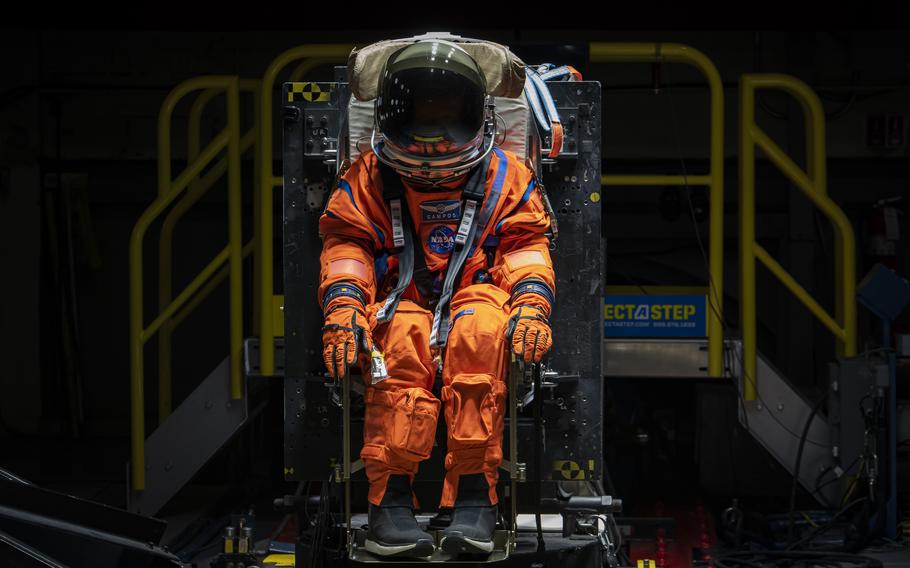
Campos, a fire and rescue training manikin, at the sled test facility at Wright-Patterson Air Force Base, Ohio, April 17, 2023, where Air Force Research Laboratory, or AFRL, and NASA staff test the seat and flight suit for safety measures. (Rick Eldridge/U.S. Air Force)
(Tribune News Service) — When NASA astronauts get suited up and seated in their newest space capsule on their next trip to the moon, it will be with the help of Air Force Research Laboratory (AFRL) researchers at Wright-Patterson Air Force Base.
Working with NASA and Lockheed Martin, AFRL researchers tested the most recent versions of the astronaut crew seat and flight suit expected to be used in the Orion spacecraft in future moon missions.
The latest work, in April, involved the Horizontal Impact Accelerator (HIA) at AFRL’s Biomedical Impact of Flight Branch at Wright-Patterson. The HIA helps researchers get a read on how the suits and the seats handle during Orion landings.
The accelerator lets AFRL and NASA assess various landing impact scenarios across all three — x, y and z — axes, letting researchers see how well the seats and flight suits handle dramatic pressures of various kinds.
Chris Perry, an AFRL biomedical researcher, simplifies the HIA concept considerably by calling it a “sled.”
“In our lab, we just call it the sled,” Perry said in a recent interview. The sled is basically an energy track 150 feet long, on which a foundation supports the Orion seat replica, holding a manikin dressed in the astronauts’ space suit.
The suit and the seat are no minor matters. This is equipment meant to keep the Artemis crew alive.
“They are very happy that AFRL has this capability,” Perry said of AFRL’s NASA and Lockheed Martin partners. ( Lockheed Martin is the Orion prime contractor).
Computer models are good, but they go only so far. With the Wright-Patterson sled, researchers get real physical data, helping them understand injury risk, the physical pressures astronauts will undergo as Orion reenters Earth atmosphere and lands in the ocean.
“When that capsule comes down and first hits that water, the occupants in their seats can be in several different orientations,” Perry said.
NASA comes to the researchers at Wright-Patt to run a physical model in the effort to make sure the suit and seat are right — by running the Orion seat on the sled, carrying the manikin.
“It all comes back to getting the right design on the seat and the suit, and how that occupant interacts with both of those to make sure they’re safe,” Perry said.
Dragged by parachutes, the Orion crew module is expected to slow from 25,000 miles per hour to around 20 mph before splashing down, AFRL said.
Astronauts are expected to visit Wright-Patterson this fall for human testing, to get further data, Perry said, although he added that volunteers may sit on the seat replica during testing.
NASA’s Artemis 2 mission is scheduled to have four astronauts venture to moon orbit, preceding Artemis 3, which is meant to be the first attempt to land on the moon since Apollo 17.
Artemis timelines are constantly changing. Currently, that mission is scheduled to launch no earlier than December 2025.
“If they need our facility, we’ll be there,” Perry said of AFRL and Wright-Patterson.
“The facilities here are quite unique,” Dustin Gohmert, Orion crew survival engineer at NASA, said in an AFRL account of the work in April. “This horizontal accelerator is one of only two or three of its kind in the whole world.”
This is the sixth or seventh time NASA researchers have been to Wright-Patterson in the last decade, Gohmert added.
(c)2023 the Dayton Daily News (Dayton, Ohio)
Visit the Dayton Daily News
Distributed by Tribune Content Agency, LLC.